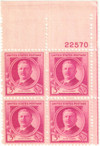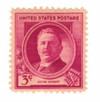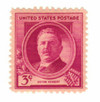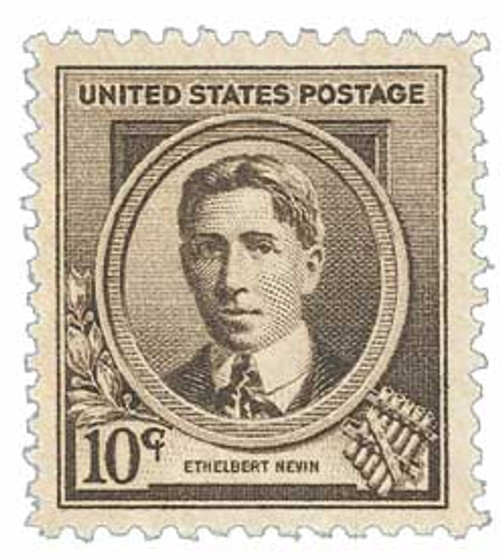
1940 Famous Americans: 3c Victor Herbert
# 881 - 1940 Famous Americans: 3c Victor Herbert
$0.35 - $30.00
U.S. #881
1940 3¢ Victor Herbert
Famous Americans Series – Composers
1940 3¢ Victor Herbert
Famous Americans Series – Composers
Issue Date: May 13, 1940
First City: New York, New York
Quantity Issued: 56,398,790
Printed by: Bureau of Engraving and Printing
Printing Method: Rotary Press
Perforation: 10 ½ x 11
Color: Bright red violet
First City: New York, New York
Quantity Issued: 56,398,790
Printed by: Bureau of Engraving and Printing
Printing Method: Rotary Press
Perforation: 10 ½ x 11
Color: Bright red violet
The subject of U.S. #881, Victor Herbert became famous for composing operettas (short, light-hearted operas). His most famous work was “Babes in Toyland,” which included characters from Mother Goose nursery rhymes in a Christmas-themed operetta. It also drew influence from the classic ballet, “The Nutcracker Suite.”
Famous Americans
In 1938, the Post Office Department announced plans for a series of stamps recognizing 10 famous Americans and invited the public to submit recommendations. The response was so great that it was decided to increase the number from 10 to 35. This required an unexpected level of organization by the Post Office Department for this series.
Seven categories were decided upon – authors, poets, educators, scientists, composers, artists, and inventors. Each category of five has the same set of denominations – 1¢, 2¢, 3¢, 5¢, and 10¢. Each rate had a valid use. The 1¢ stamp paid for a letter that was dropped off at a post office to someone who had a box at the same office. The 2¢ was for local delivery. The 3¢ paid the normal non-local mail rate, and the 5¢ and 10¢ were used in combination for heavier letters and special rates. The denominations also shared a consistent coloring scheme: 1¢ is bright blue green; 2¢ is rose carmine; 3¢ is bright red violet; 5¢ is ultramarine; and 10¢ is dark brown.
Each category has its subjects arranged with the oldest birth date going on the 1¢ stamp, down to the most recent birth date on the 10¢ stamp. Each category has its own dedicated symbol in the engraving – a scroll, quill pen and inkwell for authors; a winged horse (Pegasus) for poets; the “Lamp of Knowledge” for educators; laurel leaves and the pipes of the Roman god Pan for composers; and inventors had a cogwheel with uplifted wings and a lightning flash to symbolize power, flight, and electricity.
The artists and the scientists have multiple symbols. Artists have either a paint palette and brush (for painters), and the sculptors have a stonecutting hammer and chisel. Scientists had the classical symbol of their particular profession.
U.S. #881
1940 3¢ Victor Herbert
Famous Americans Series – Composers
1940 3¢ Victor Herbert
Famous Americans Series – Composers
Issue Date: May 13, 1940
First City: New York, New York
Quantity Issued: 56,398,790
Printed by: Bureau of Engraving and Printing
Printing Method: Rotary Press
Perforation: 10 ½ x 11
Color: Bright red violet
First City: New York, New York
Quantity Issued: 56,398,790
Printed by: Bureau of Engraving and Printing
Printing Method: Rotary Press
Perforation: 10 ½ x 11
Color: Bright red violet
The subject of U.S. #881, Victor Herbert became famous for composing operettas (short, light-hearted operas). His most famous work was “Babes in Toyland,” which included characters from Mother Goose nursery rhymes in a Christmas-themed operetta. It also drew influence from the classic ballet, “The Nutcracker Suite.”
Famous Americans
In 1938, the Post Office Department announced plans for a series of stamps recognizing 10 famous Americans and invited the public to submit recommendations. The response was so great that it was decided to increase the number from 10 to 35. This required an unexpected level of organization by the Post Office Department for this series.
Seven categories were decided upon – authors, poets, educators, scientists, composers, artists, and inventors. Each category of five has the same set of denominations – 1¢, 2¢, 3¢, 5¢, and 10¢. Each rate had a valid use. The 1¢ stamp paid for a letter that was dropped off at a post office to someone who had a box at the same office. The 2¢ was for local delivery. The 3¢ paid the normal non-local mail rate, and the 5¢ and 10¢ were used in combination for heavier letters and special rates. The denominations also shared a consistent coloring scheme: 1¢ is bright blue green; 2¢ is rose carmine; 3¢ is bright red violet; 5¢ is ultramarine; and 10¢ is dark brown.
Each category has its subjects arranged with the oldest birth date going on the 1¢ stamp, down to the most recent birth date on the 10¢ stamp. Each category has its own dedicated symbol in the engraving – a scroll, quill pen and inkwell for authors; a winged horse (Pegasus) for poets; the “Lamp of Knowledge” for educators; laurel leaves and the pipes of the Roman god Pan for composers; and inventors had a cogwheel with uplifted wings and a lightning flash to symbolize power, flight, and electricity.
The artists and the scientists have multiple symbols. Artists have either a paint palette and brush (for painters), and the sculptors have a stonecutting hammer and chisel. Scientists had the classical symbol of their particular profession.
















